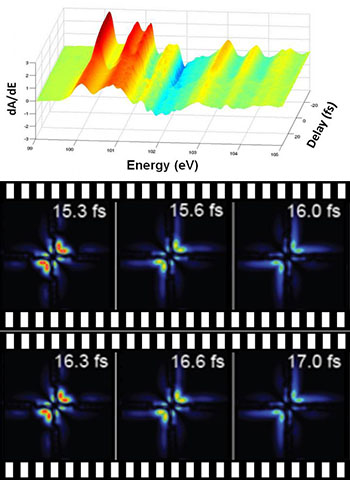
Ultrafast laser spectroscopy has allowed scientists to resolve the 450 attosecond jump of electrons from the valence to conduction band in a semiconducting crystal (top) and the pulsing motion of a helium electron pair in a single-femtosecond “beat” (bottom). [Images: Top, Stephen Leone & Daniel Neumark, Attosecond Physics Laboratory, UC Berkeley; bottom, Max Planck Institute for Nuclear Physics]
Two recently published studies have highlighted the role of extreme-ultraviolet (XUV), attosecond laser spectroscopy in probing the ultrafast dance of electrons. In one study, a team of scientists from the United States, Japan and Germany used pulses of attosecond X-ray light to create “snapshots” of electrons tunneling through the band gap from valence to conduction band in a semiconductor. And in the other, researchers in Germany and Spain used attosecond XUV pulses to image and control the motion of two-electron wave packets in atomic helium.
Jumping band gap: The motion picture
The first study (Science, doi: 10.1126/science.1260311) focused on a process fundamental to semiconductor physics and, indeed, to all of modern electronics: the transfer of electrons from the valance to conduction band states. In particular, the scientists looked at the well-known photoelectric effect, the excitation of electrons in metals or semiconducting materials by incident light.
For semiconductors in particular, hitting the ordinarily non-conducting material with high-intensity laser light of the right wavelength can excite the electrons and cause them to tunnel through the band gap from the valence band to the conduction band, making the material temporarily conductive. The transition from valance to conduction band underlies the behavior of the diodes and transistors that are central to modern electronics and computing. But the speed of the transition—on the order of 450 attoseconds, or 450 billionths of a nanosecond—has made it difficult to study in detail.
To crack that problem, the authors of the new study fired ultrashort pulses of near-infrared light at a semiconducting silicon crystal to kick electrons into the conduction band. They subsequently irradiated the material with XUV laser pulses a few tens of attoseconds in duration.
Changes in the XUV absorption spectra of the material allowed the team to track the excitation process on timescales short enough to allow snapshots that could be combined into a “movie” documenting the excitation and band gap jumping process, according to team leader Stephen Leone of the University of California, Berkeley, USA. And the time resolution of the technique allowed the team to distinguish between the electron transfer, operating at half-femtosecond rates, and the much slower (around 60 femtosecond) band gap modifications attributable to mechanical lattice motions in the wake of electron transfer.
Electron-pair choreography
The second study harnessing XUV attosecond spectroscopy (Nature, doi: 10.1038/nature14026) focused on a different kind of electron movement: the motion of multiple bound electrons in a free atomic system. Such motions lie at the heart of the chemical reactions that bind atoms into molecules. But while the motion of single electrons has been observed, even at attosecond timescales, observation of correlated motion of multiple electrons has been a thornier problem.
To attempt to capture the pulsing motion of correlated electron pairs in the helium atom, the German-Spanish team turned, again, to XUV attosecond laser spectroscopy. In these experiments, they sent ultraviolet attosecond laser pulses through a chamber of helium gas to start the electrons pulsing at a 1.2 femtosecond quantum “beat” characteristic of a correlated two-electron wave packet. The beat showed up in the transient attosecond absorption spectra.
They then used a weak visible laser pulse to illuminate the atoms. By tweaking both the delay between the UV and visible pulses and the visible pulse intensity, they were able to reconstruct the position of the electrons at extremely short time slices, and even to control the motion of the two-electron system.
The scientists believe that the ability to understand, and control, the motion of these two-electron states could ultimately lead to new kinds of chemistry. For example, it’s conceivable that someday ultrashort, tailored light fields might be used to nudge electron systems into favorable configurations for the creation of new, exotic molecules “beyond the reaches of traditional chemistry,” according to the paper.
